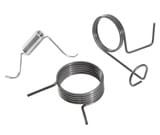 A torsion spring calculator is a software tool used to calculate the dimensions, tolerances, weight, and other design specifications for a torsion spring—the helical-shaped, coiled springs used in applications to exert torque or store rotational energy in a radial direction. Torsion spring calculator software allows a user to not only accurately calculate the design of a torsion spring, but analyze a broad range of variables to offer a complete solution for the design and remove any guesswork.
A torsion spring calculator is a software tool used to calculate the dimensions, tolerances, weight, and other design specifications for a torsion spring—the helical-shaped, coiled springs used in applications to exert torque or store rotational energy in a radial direction. Torsion spring calculator software allows a user to not only accurately calculate the design of a torsion spring, but analyze a broad range of variables to offer a complete solution for the design and remove any guesswork.
For the helical torsion spring calculator to calculate the size needed for a torsion spring to function, a user needs to know the application requirements and have some or all of the design data. Once the user enters the data, a torsion spring calculator does the math. Users simply enter the direction of the wind, clockwise or counter-clockwise, in the appropriate fields, and then add the spring dimensions—its diameters, number of coils, and the length of each leg. Once the physical dimensions for an original design have been entered into a torsion spring calculator, it can easily be adjusted until the ideal load requirements for an application have been met.
Calculations for torsion springs differ with each torsion spring application. The one constant is that a torsion spring is wound from spring wire coiled into a cylindrical shape. The wire is not fully coiled in torsion spring designs, rather, wire on each end of the spring extends out straight from the cylinder at a certain angle, essentially creating legs on either end of the coil. The length of either leg and its angle is calculated to meet the design requirements for an application. By applying a pushing force on one of the wire legs while keeping the other wire leg fixed, a rotational force response from the spring is achieved. Because every application for a torsion spring is unique, every device requires its own defined rate of rotational force provided by the spring when loaded at a certain angle.
Common Torsion Spring Material
Like any spring, the material used for a torsion spring affects its performance, durability, and resistance to fatigue failure. However, the shape and size of the wire used to make a torsion spring determines its torque capacity and deflection characteristics. Specifications for each torsion spring design must be calculated with precision for the application to work as intended. The angular energy of a torsion spring for a mousetrap or garage door, for example, is as different as a static clamp mechanism for a clothespin or clipboard.
Each torsion spring, whether it is designed to hold objects in place or push them back to their original position, is different. In applications, the only constant in design is that the legs of torsion springs are attached to other components or objects set to rotate around the center or axis of the spring. As for design differences, a torsion spring can be close wound but also have a pitch to reduce friction between the coils. Also, a torsion spring’s rotational applied force is omnidirectional. Meaning, the spring’s torque force can be designed to work clockwise or counter-clockwise, whatever the direction the load requires.
Benefits of a Torsion Spring Calculator
Torsion spring formulas for rate, maximum load, and maximum deflection are difficult to calculate due to the different tensile strengths of materials in different diameters. This makes the calculations time-consuming and delicate, requiring careful consideration of the material type and manufacturing process. A torsional spring calculator simplifies this process by quickly calculating spring dimensions based on input data.
Users will need to enter the direction of the wind and the appropriate spring dimensions into the appropriate fields of the torsion spring calculator software. For example, wire diameter, outer diameter, inner diameter, number of coils, and the lengths of each leg would be entered. As material affects a spring’s performance, durability, resistance, and other mechanical properties, calculators also allow users to select the desired spring material for their application.
In sum, a torsion spring calculator is a software tool used by design engineers to accurately calculate the force and elasticity requirements, as well as the required loads, rate, and distance traveled for torsion spring applications. Calculators can be used to acquire stock torsion springs from manufacturers or for testing and prototyping springs for a particular application.
Custom Spring Manufacturing
James Spring & Wire Company is an industry leader in the custom manufacture of springs. In particular, we have the capability to manufacture custom torsion springs as needed by our customers. Our torsion spring calculator software tool will accurately calculate torque capacity, spring rate, and other performance characteristics to ensure your spring meets the specific design requirements for your application. For more information, please contact one of our team members today to discuss your project goals.

